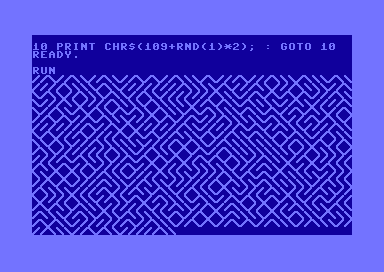10 PRINT CHR$(205.5+RND(1)); : GOTO 10
This one-line poem code poem for the Commodore 64 produces the output you see in the screen capture above, though this short video documentation will show it in action. When executed, it randomly generates one of two characters, / or \ , repeating the operation forever, unless interrupted. This poem will be the subject of an MIT Press book which will feature 10 academics writing about this code work from different perspectives. The emergent complexity from this deceptively simple work is part of its interest. The results you see in the image and video are from emulated version, which seek to replicate the computational conditions in which this version of BASIC ran, the Commodore 64. This popular computer system from the 1980s had a video output of it of 40 columns of text, using the PETSCII character set, which meant that the code poem would produce 40 / or \ before needing to go to the next line. The monospaced font meant that the characters would line up perfectly to produce the results you see. But what do you see when you look at this output? I see a labyrinth, which I try to navigate with my gaze. I see letters, such as the E, F, P, a square-top A, O (or is it 0?). I see great complexity emerge from such a simple line of code, the kind that is incomplete without a human being to read into it. We can look at this maze as a visual art object, but let’s not forget we’re also reading characters: unvoiced parts of our alphabet, this building block of written language. I see a poem.
(Source: Leonardo Flores)
Critical writing that references this work:
|
Title |
Author | Year |
|---|---|---|
| I Love E-Poetry | Leonardo L. Flores | 2011 |


